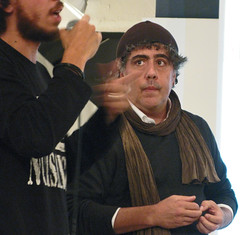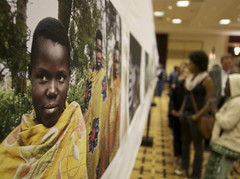AP photo editor brings pictures and career in photojournalism to life

Associated Press photographer Santiago Lyon instructs Claire Higgins, editor of Northern Kentucky University’s student newspaper during a workshop. The workshop followed Lyon’s talk for NKU’s Six@Six Lecture Series. (Photo by NKU photographer Timothy Sofranko)?
By Mark Neikirk
Special to KyForward
Santiago Lyon?s day began on Nov. 16 with some disturbing news. An Associated Press photographer?s car had been struck by a rocket as Israeli and Hamas forces exchanged fire in the latest hostilities over Gaza. Fortunately, the photographer was out of his car when the rocket hit. He was uninjured aside from some ringing in his ears.
It was Lyon?s job to know what happened, make sure it got AP?s full attention and that the photographer promptly received whatever medical care he might need.
As vice president and director of photography for the AP, Lyon oversees some 300 photographers worldwide ? a job that involves not only a good eye for pictures but also a good head for logistics and a strong sense of how to protect the safety of his employees who, by the nature of news photography, are often in harm?s way. ?At the tip of the spear,? as Lyon puts it.
On this morning, Lyon was on his way to Northern Kentucky University, where the night before he had delivered a 90-minute lecture, ?Photojournalism: Then and Now,? to a packed house in the Digitorium of NKU?s College of Informatics. Lyon took the audience on a tour through AP?s stunning contributions to photojournalism, with iconic photos at Iwo Jima, of Adlai Stevenson?s worn shoe sole, of a napalmed girl fleeing on a Vietnam back road and of hundreds upon hundreds of other images that recorded wars, disasters, campaigns and, just as often, everyday life.
Of course, the world doesn?t slow down just because AP?s photo editor is not as his desk in New York. So returning to campus for a morning workshop with journalism students, Lyon used to ride from the hotel to manage the mini-crisis in Gaza via smart phone.
By 9 a.m., Lyon was in the newsroom of the Northerner, NKU?s campus newspaper, talking to students about his day so far and giving them a sort of live action example of what it means to direct the photo desk for the world?s largest and most storied news service. After the newsroom session, Lyon took the students on a campus tour with cameras in hand for a master class in how to look for subjects, interact with them and come away with poignant, well-composed pictures that tell stories.
?Shoot people,? Northerner Editor Claire Higgins said, recalling Lyon?s advice. ?And make sure you interact with the people you are shooting. Build trust.?

The lecture series is so named because there are six lectures at 6 p.m. for $6.
The students got a more direct lesson in what that means when asked to shoot a sushi chef working behind the counter in the NKU Student Union food court. Lyon wanted to know: What are his hobbies and interests? Was he born in America? How did he get here? Did his family come with him? In short, did you get to know your subject a little before you snapped his picture? The answer was ?no? ? but the lesson was learned.
?The photography workshop with Santiago Lyon was a superb chance for my students to have some one-on-one time with someone who understands photojournalism,? said journalism professor Matthew Baker, who accompanied Lyon and the students. ?The students received personal critiques of their photos and techniques in the field. We spent time in the Student Union taking photos and talking technique. For me, one of the greatest moments was after a student spent some time making photos of a sushi chef, she handed her camera to Lyon, who flipped through her images and talked about how she could interact and build a relationship with her subject to improve her photographs. The other great moment came when I met with my class and listened to the students who attended tell the students who didn?t attend what they missed.?
Lyon was at NKU as part of the university?s?Six@Six Lecture Series, now in its third season and so named because there are six lectures at $6 each that start at 6 p.m.
Five of the six lectures feature NKU faculty members who talk on subjects for which they have a special passion and expertise. The sixth lecture is an AP guest and reflects a relationship NKU has built with AP through the NKU Newspaper Readership Program. Lyon was the third AP journalist to participate in Six@Six. International affairs editor John Daniszewski spoke in 2010 on foreign affairs reporting and political editor Liz Sidoti spoke in 2011 on the coming 2012 presidential campaign.
The Readership Program partners also include the New York Times and USA Today. All three are available daily at NKU (AP online only; the Times and USA Today in print and online) to create a climate of inquiry on campus around public affairs and public policy. ?Both programs, Six@Six and the Readership Program, are coordinated by NKU?s Scripps Howard Center for Civic Engagement, which works to connect the campus and community.
Six@Six is an eclectic mix of topics, made possible by the wide variety of disciplines taught at the university, from history to law, from psychology to physics. The basic idea behind the series is to export the intellectual capacity of NKU to the community. The series includes a partnership with three community institutions that, like NKU, are dedicated to culture and education: the Behringer-Crawford Museum in Covington?s Devou Park; the Mercantile Library in downtown Cincinnati; and the Carnegie Visual and Performing Arts Center, also in Covington. The lectures move among those venues and NKU through the season.
This season opened with a lecture by John Bickers, associate professor of law at NKU?s Salmon P. Chase College of Law. His topic was ?Forever Free: The Constitutionality of the Emancipation Proclamation.? Professor Bickers explained how Lincoln, a strict constructionist in constitutional law, found a way to free slaves in the rebellious states by using his war powers as the nation?s commander in chief. The lecture was delivered during the week that marked the 150th anniversary of Antietam, the bloody battle that provided Lincoln with the victory he felt he needed to issue the Emancipation Proclamation. An interesting footnote to the lecture is that attendees who have since seen the new movie, Lincoln, heard Daniel Day-Lewis, playing the president, offer a shortened version of that rationale as part of the movie?s dialogue.
The next Six@Six lecture will be Dec. 4, when Cecile Marczinki, an assistant professor of psychology, will speak on ?Energy Cocktails: What are the Risks??? Other topics this season are atomic structure, forensic science and Machiavelli.
Lyon?s lecture included a history of wire photography, including the story of the first transmission ? a plane crash ? made by telephone line in 1935. If you Google that, you?ll likely find an aerial photo of a snowy woods with the downed plane barely visible among the trees. In his research for his Six@Six lecture, Lyon found out that was actually the second photo. The first was another shot of the crash scene, taken from the ground.
The synergy of the Six@Six Lectures and the Newspaper Readership Program reflect an NKU effort to provide public engagement programming that is value both on campus and in the community.
Because of the on-campus, or internal, component, speakers such as Lyon are asked to work with students during their visit. He met for about 90 minutes with 25 students from journalism, photography and Spanish (he began his journalism career translated stories from English to Spanish) classes. He told his life story and advised students to, ?Make a plan. Make a short-term plan and make a long-term plan.? When he asked one student, ?What?s your plan?? and the student replied, half in jest, ?To graduate,? Lyon counseled him to think beyond that. What?s your passion? What career to you want? How will you get started? Where do you want to end up?
That evening, the students who attended the dialogue helped pack the lecture room, which holds 120 people. Lyon provided a look back at AP?s photo archive but also included portfolios of current work, including pictures from the 2012 presidential campaign, the devastation by Super Storm Sandy and the war in Afghanistan. One group of photos that drew a few chuckles showed polling places from across the county ? a series that captured the Americana feel of Election Day, with voters in churches, VFW halls, schools and local restaurants. The mood changed with an especially haunting portfolio from AP photographer Emilio Morenatti?s work depicting Pakistani women who were horrifyingly disfigured by acid, often because their families had accused them of dishonoring the family in some fashion.
How was Lyon?s lecture received? Comment cards collected after the lecture told that story:
?Awed. Rewarding. Powerful.?
?I loved seeing all the firsthand photos and hearing the stories behind them.?
?Breathtaking images.?
?I loved getting to see all of the photos from different times in history and seeing all of the emotion in the photos.?
?Enlightening. Moving. Informative.
Mark Neikirk is executive director of the?Scripps Howard Center for Civic Engagement?at Northern Kentucky University.



